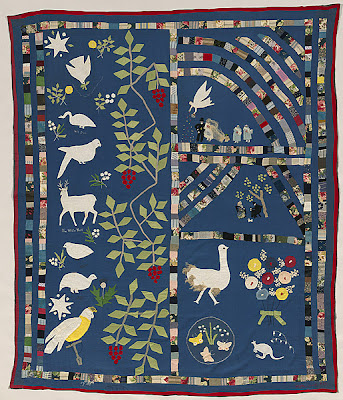I can’t leave "Tamworth" without commenting on how
difficult it has been so far to “recollect” details of my quilts. Despite leaving a fairly decent paper trail
courtesy of TAFE notes, photos, diaries and a feeble attempt to make up a Quilt
Album (a bit of a fad in the 1980/90’s) I still find it difficult to date my
quilts in detail. Yes, I do sign and date
my quilts – an early “must do” subscribed to by teacher Joc at
Queenscliff - but only with the basics. I’ve since made up a few labels with additional information such as quilt
titles and try to embroider this detail rather than just pen it on.
Keeping an annual appointment diary also
helped as has my list preoccupation. At
the end of 1996 I must have decided to write up a wish-list (with pattern details)
and added to it my UFO’s, which seemed to be getting out of hand. Most years since, I’ve made this list-making my New Year’s
priority. That way I can keep a promise
to myself to finish off at least one UFO a year (regardless of how much I
really dislike it) before surrendering to something new or signing up for an
impossible to finish workshop schedule.
What brought me to comment on the value of labelling
quilts? The Armidale Symposium in 1990 held
a Quilt Exhibition (14-19 September 1990) as part of its activities. Aside from nearly 100 quilts from members and
Symposium teachers, the exhibition had a special showing of two 1920's quilts by Mary
Jane Hannaford, of Blandford (and also Tamworth), NSW.
Margaret Rolfe mentions an unknown MJH in her 1987 book, Patchwork Quilts in Australia. At that time little was known of
the elusive MJH, however, at least 3 of her quilts were in the safe hands of the Australian National Gallery at that time. (See photos above & below). Because MJH initialled
and dated her works, we now know of a further 4 quilts (6 are now held at the NGA along with a workbook of poems and sketches) and at least
one other quilt, owned by a private collector. Research and information has brought to light her name, her history and a little more of her life details.
We also have a
wonderful on-line resource in the National Quilt Register, so if you have
something that could enhance our understanding of early Australian life and textiles,
help this resource list to grow.
It is best then, to follow the advice in just about every
quilting book out there and sign and date your work at the very least. Future family members, quilt historians or
owners may just want a little provenance with your quilt legacy left to them.
Sadly, I don't have any photos from the Armidale exhibition but I did copy down a poem written by MJH. She was indeed an inspiring and creative spirit from our early history.
Omission
It isn't the thing you do, dear
It's the thing you have left undone,
Which gives you a bit of a heartache
At the setting of the sun.
The tender word forgotten,
The letter you did not write,
The flower you might have sent, dear
Are your haunting ghosts tonight
The stone you might have lifted
Out of a brother's way,
For life is all too short
And sorrow is all too great
And it's not the thing you do
It's the thing you leave undone,
Which gives you a bit of a heartache
At the setting of the sun.
written by Mary Jane Hannaford, 1840-1930












